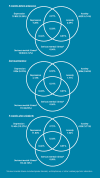Impact of socioeconomic deprivation on maternal perinatal mental illnesses presenting to UK general practice
- PMID: 23265226
- PMCID: PMC3459774
- DOI: 10.3399/bjgp12X656801
Impact of socioeconomic deprivation on maternal perinatal mental illnesses presenting to UK general practice
Abstract
Background: Although maternal perinatal mental illnesses commonly present to and are primarily treated in general practice, few population-based estimates of this burden exist, and the most affected socioeconomic groups of pregnant women remain unclear.
Aim: To provide estimates of maternal depression, anxiety and serious mental illness (SMI) in UK general practice and quantify impacts of socioeconomic deprivation.
Design and setting: Cross-sectional analysis of prospectively recorded general practice records from a UK-wide database.
Method: A pregnancy ending in live birth was randomly selected for every woman of childbearing age, 1994-2009. Prevalence and diagnostic overlap of mental illnesses were calculated using a combination of medical diagnoses and psychotropic drug prescriptions. Socioeconomic deprivation was assessed using multivariate logistic regression, adjusting for calendar period and pregnancy history.
Results: Among 116 457 women, 5.1% presented with antenatal depression and 13.3% with postnatal depression. Equivalent figures for anxiety were 2.6% and 3.7% and for SMI 1/1000 and 2/1000 women. Socioeconomic deprivation increased the risk of all mental illnesses, although this was more marked in older women. Those age 35-45 years in the most deprived group had 2.63 times the odds of antenatal depression (95% confidence interval [CI] = 2.22 to 3.13) compared with the least deprived; in women aged 15-25 years the increased odds associated with deprivation was more modest (odds ratio = 1.35, 95% CI = 1.07 to 1.70). Similar patterns were found for anxiety and SMI.
Conclusion: Strong socioeconomic inequalities in perinatal mental illness persist with increasing maternal age. Targeting detection and effective interventions to high-risk women may reduce inequity and avoid substantial psychiatric morbidity.
Figures
Comment in
-
Mental illness is prevalent among U.K. women in the perinatal period and is associated with socioeconomic deprivation.Evid Based Ment Health. 2013 May;16(2):57. doi: 10.1136/eb-2013-101226. Epub 2013 Mar 16. Evid Based Ment Health. 2013. PMID: 23503977 No abstract available.
References
-
- Oates M. Perinatal psychiatric disorders: a leading cause of maternal morbidity and mortality. Br Med Bull. 2003;67:219–229. - PubMed
-
- Jablensky AV, Morgan V, Zubrick SR, et al. Pregnancy, delivery, and neonatal complications in a population cohort of women with schizophrenia and major affective disorders. Am J Psychiatry. 2005;162(1):79–91. - PubMed
-
- Howard LM, Goss C, Leese M, Thornicroft G. Medical outcome of pregnancy in women with psychotic disorders and their infants in the first year after birth. Br J Psychiatry. 2003;182(1):63–67. - PubMed
Publication types
MeSH terms
Substances
LinkOut - more resources
Full Text Sources
Medical

